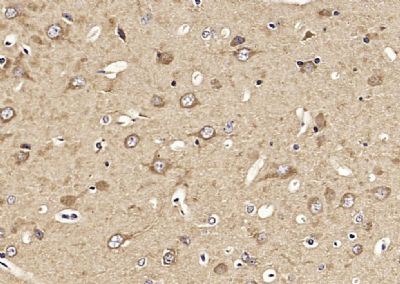KIF1A Polyclonal Antibody
Purified Rabbit Polyclonal Antibody (Pab)
- 产品详情
- 实验流程
Application
| IHC-P, IHC-F, IF, ICC, E |
|---|---|
| Primary Accession | Q12756 |
| Reactivity | Rat, Pig, Dog, Bovine |
| Host | Rabbit |
| Clonality | Polyclonal |
| Calculated MW | 191064 Da |
| Physical State | Liquid |
| Immunogen | KLH conjugated synthetic peptide derived from human KIF1A |
| Epitope Specificity | 1-100/1690 |
| Isotype | IgG |
| Purity | affinity purified by Protein A |
| Buffer | 0.01M TBS (pH7.4) with 1% BSA, 0.02% Proclin300 and 50% Glycerol. |
| SUBCELLULAR LOCATION | Cytoplasm, cytoskeleton. Note=Expressed in distal regions of neurites. |
| SIMILARITY | Belongs to the kinesin-like protein family. Unc-104 subfamily.Contains 1 FHA domain.Contains 1 kinesin-motor domain.Contains 1 PH domain. |
| SUBUNIT | Monomer. Interacts with PPFIA1 and PPFIA4 (By similarity). |
| DISEASE | Spastic paraplegia 30, autosomal recessive (SPG30) [MIM:610357]: A form of spastic paraplegia, a neurodegenerative disorder characterized by a slow, gradual, progressive weakness and spasticity of the lower limbs. Rate of progression and the severity of symptoms are quite variable. Initial symptoms may include difficulty with balance, weakness and stiffness in the legs, muscle spasms, and dragging the toes when walking. In some forms of the disorder, bladder symptoms (such as incontinence) may appear, or the weakness and stiffness may spread to other parts of the body. SPG30 is characterized by onset in the first or second decades of unsteady spastic gait and hyperreflexia of the lower limbs. Note=The disease is caused by mutations affecting the gene represented in this entry.Hereditary sensory neuropathy 2C (HSN2C) [MIM:614213]: A neurodegenerative disorder characterized by onset in the first decade of progressive distal sensory loss leading to ulceration and amputation of the fingers and toes. Affected individuals also develop distal muscle weakness, primarily affecting the lower limbs. Note=The disease is caused by mutations affecting the gene represented in this entry.Mental retardation, autosomal dominant 9 (MRD9) [MIM:614255]: A disorder characterized by significantly below average general intellectual functioning associated with impairments in adaptative behavior and manifested during the developmental period. Note=The disease is caused by mutations affecting the gene represented in this entry. |
| Important Note | This product as supplied is intended for research use only, not for use in human, therapeutic or diagnostic applications. |
| Background Descriptions | The kinesins constitute a large family of microtubule-dependent motor proteins, which are responsible for the distribution of numerous organelles, vesicles and macromolecular complexes throughout the cell. Individual kinesin members play crucial roles in cell division, intracellular transport and membrane trafficking events including endocytosis and transcytosis. KIF1C is a member of the KIF1/Unc104 family of kinesin-like proteins, which are involved in the transport of mitochondria or synaptic vesicles in axons. The human KIF1A gene encodes a neuron-specific motor protein that delivers synaptic vesicle precursors to nerve terminals. KIF1A is a monomeric, globular molecule and has rapid anterograde motor activity (1.2 microns/s). KIF1A-mediated axonal transport plays a critical role in viability, maintenance and function of neurons, particularly mature neurons. KIF1A is associated with organelles that contain synaptic vesicle proteins such as synaptotagmin, synaptophysin and Rab 3A. |
| Gene ID | 547 |
|---|---|
| Other Names | Kinesin-like protein KIF1A, Axonal transporter of synaptic vesicles, Microtubule-based motor KIF1A, Unc-104- and KIF1A-related protein, hUnc-104, KIF1A, ATSV, C2orf20 |
| Target/Specificity | Expressed in neurons. |
| Dilution | IHC-P=1:100-500,IHC-F=1:100-500,ICC=1:100-500,IF=1:100-500,ELISA=1:5000-10000 |
| Storage | Store at -20 °C for one year. Avoid repeated freeze/thaw cycles. When reconstituted in sterile pH 7.4 0.01M PBS or diluent of antibody the antibody is stable for at least two weeks at 2-4 °C. |
| Name | KIF1A |
|---|---|
| Synonyms | ATSV, C2orf20 |
| Function | Kinesin motor with a plus-end-directed microtubule motor activity (By similarity). It is required for anterograde axonal transport of synaptic vesicle precursors (PubMed:33880452). Also required for neuronal dense core vesicles (DCVs) transport to the dendritic spines and axons. The interaction calcium-dependent with CALM1 increases vesicle motility and interaction with the scaffolding proteins PPFIA2 and TANC2 recruits DCVs to synaptic sites. |
| Cellular Location | Cytoplasm, cytoskeleton. Cell projection, neuron projection. Cell projection, axon {ECO:0000250|UniProtKB:P33173}. Cytoplasm, perinuclear region {ECO:0000250|UniProtKB:P33173}. Synapse {ECO:0000250|UniProtKB:P33173} Cytoplasmic vesicle, secretory vesicle, neuronal dense core vesicle membrane {ECO:0000250|UniProtKB:F1M4A4}; Peripheral membrane protein {ECO:0000250|UniProtKB:F1M4A4}; Cytoplasmic side {ECO:0000250|UniProtKB:F1M4A4}. Note=Within neuronal cells concentrated in the axon, with smaller amounts in the perinuclear and synaptic regions (By similarity). Accumulates at the distal tip of growing neurites. {ECO:0000250|UniProtKB:P33173, ECO:0000269|PubMed:25265257, ECO:0000269|PubMed:33880452} |
| Tissue Location | Expressed in neurons. |
Research Areas
For Research Use Only. Not For Use In Diagnostic Procedures.
Application Protocols
Provided below are standard protocols that you may find useful for product applications.
终于等到您。ABCEPTA(百远生物)抗体产品。
点击下方“我要评价 ”按钮提交您的反馈信息,您的反馈和评价是我们最宝贵的财富之一,
我们将在1-3个工作日内处理您的反馈信息。
如有疑问,联系:0512-88856768 tech-china@abcepta.com.
¥ 1,500.00
Cat# AP54465























 癌症的基本特征包括细胞增殖、血管生成、迁移、凋亡逃避机制和细胞永生等。找到癌症发生过程中这些通路的关键标记物和对应的抗体用于检测至关重要。
癌症的基本特征包括细胞增殖、血管生成、迁移、凋亡逃避机制和细胞永生等。找到癌症发生过程中这些通路的关键标记物和对应的抗体用于检测至关重要。 为您推荐一个泛素化位点预测神器——泛素化分析工具,可以为您的蛋白的泛素化位点作出预测和评分。
为您推荐一个泛素化位点预测神器——泛素化分析工具,可以为您的蛋白的泛素化位点作出预测和评分。 细胞自噬受体图形绘图工具为你的蛋白的细胞受体结合位点作出预测和评分,识别结合到自噬通路中的蛋白是非常重要的,便于让我们理解自噬在正常生理、病理过程中的作用,如发育、细胞分化、神经退化性疾病、压力条件下、感染和癌症。
细胞自噬受体图形绘图工具为你的蛋白的细胞受体结合位点作出预测和评分,识别结合到自噬通路中的蛋白是非常重要的,便于让我们理解自噬在正常生理、病理过程中的作用,如发育、细胞分化、神经退化性疾病、压力条件下、感染和癌症。






